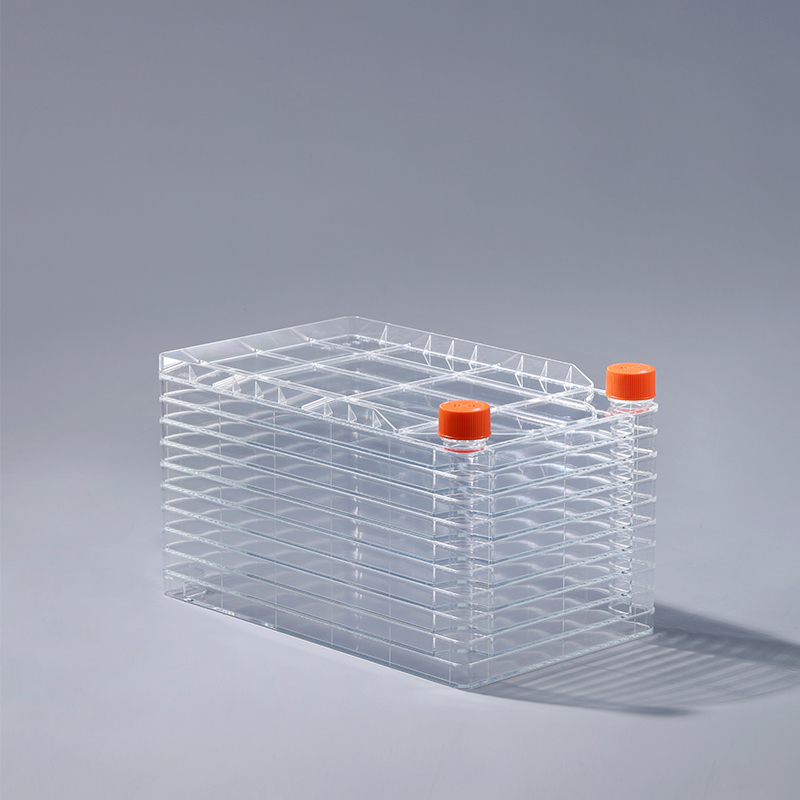یک دستگاه کشت سلولی است که از یک یا چند لایه با توجه به اندازه ناحیه کشت تشکیل شده است که می تواند کشت سلولی در مقیاس بزرگ را محقق کند و برای بسیاری از زمینه ها مانند واکسن، صنعت داروسازی مناسب است. یا آنتی بادی کلون مونومر.کارخانه سلولی میتواند کشت سلولی چسبنده را برآورده کند و همچنین برای کشت استاتیک سلولهای سوسپانسیون مناسب است. کشت چسبنده به این معنی است که سلول ها هنگام کشت باید به دیواره ظرف کشت (بطری) متصل شوند. هنگامی که سلول ها متصل شدند، به سرعت پخش می شوند، سپس میتوز شروع می شود و به سرعت وارد فاز رشد لگاریتمی می شوند. به طور کلی چند روز بعد، سطح کشت پوشیده می شود و یک تک لایه سلولی متراکم تشکیل می شود، مانند سلول های Vero، سلول های HEK 293، سلول های CAR-T، سلول های MRC5، CEF، ماکروفاژهای آلوئولی خوک، سلول های میلوما، سلول های DF-1، سلولهای ST، سلولهای PK15، سلولهای Marc145 و غیره همگی روشهای کشت چسبنده را اتخاذ میکنند.cell factory
کشت سوسپانسیون به یک سیستم کشت بافتی اشاره دارد که سلولهای منفرد و خوشههای سلولی کوچک را در یک محیط مایع کشت میکند که دائماً هم زده یا تکان میخورد. رشد سلول های معلق به سطح تکیه گاه بستگی ندارد و در محیط کشت در حالت معلق رشد می کند. به عنوان مثال، سلولهای CHO، سلولهای حشره، سلولهای BHK21 و سلولهای MDCK همگی در کشت سوسپانسیون استفاده میشوند.
کارخانه سلولی از مزایای ساختار چند لایه و مساحت بزرگ استفاده میکند و به طور گسترده در تولید انبوه صنعتی برای برآورده کردن شرایط استفاده میشود. نیاز دوگانه فرهنگ پایبند و فرهنگ تعلیق است و مورد علاقه بسیاری از موسسات تحقیقاتی علمی و شرکت های دارویی است.
The cell factory utilizes the advantages of multi-layer structure and large area, and is widely used in industrial mass production to meet the dual needs of adherent culture and suspension culture, and is favored by many scientific research institutions and pharmaceutical companies.
The FAI climbed 5.9 percent year-on-year in the first 11 months of 2018, quickening from the 5.7-percent growth in Jan-Oct, the National Bureau of Statistics (NBS) said Friday in an online statement.
The key indicator of investment, dubbed a major growth driver, hit the bottom in August and has since started to rebound steadily.
In the face of emerging economic challenges home and abroad, China has stepped up efforts to stabilize investment, in particular rolling out measures to motivate private investors and channel funds into infrastructure.
Friday's data showed private investment, accounting for more than 60 percent of the total FAI, expanded by a brisk 8.7 percent.
NBS spokesperson Mao Shengyong said funds into weak economic links registered rapid increases as investment in environmental protection and agriculture jumped 42 percent and 12.5 percent respectively, much faster than the average.
In breakdown, investment in high-tech and equipment manufacturing remained vigorous with 16.1-percent and 11.6-percent increases respectively in the first 11 months. Infrastructure investment gained 3.7 percent, staying flat. Investment in property development rose 9.7 percent, also unchanged.
 English
English



















































